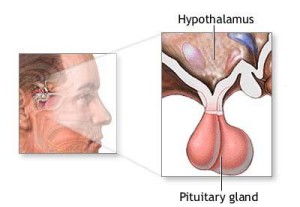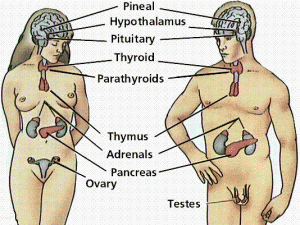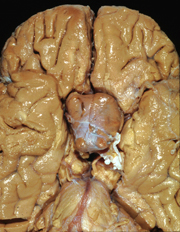What is the pituitary gland?
- Sometimes called the master gland, the pituitary gland plays a critical role of ‘remote control’ in regulating growth and development, metabolism, and reproduction. This gland produces a few hormones
- Prolactin causes milk secretion in pregnant women after child birth.
- Growth hormone, which as the name indicates, regulates growth
- ACTH (adrenocorticotropin hormone) which stimulates the adrenal glands to produce cortisol, especially during stress (surgery, etc.)
- Thyroid stimulating hormone (TSH), which signals the thyroid gland to produce thyroid hormone
- Luteinizing hormone (LH) and follicle-stimulating hormone (FSH), which regulate ovulation and estrogen and progesterone production in women, and sperm formation and testosterone production in men.
Pituitary Adenomas
- Pituitary adenomas are typically benign, slow-growing tumors that arise from cells in the pituitary gland.
- Pituitary adenomas are relatively common, occurring in 1 out every 1000 adults.
- Most pituitary tumors are benign and are called adenomas.
- Pituitary adenomas are typically slow growing
- Some pituitary adenomas, although still benign, can invade adjacent structures (such the cavernous sinus, an area where the carotid arteries run
- Pituitary adenomas have separate names based on their size
- A microadenoma is less than 1 cm in diameter
- A macroadenoma is larger than 1 cm in size
Clinical Features
Pituitary adenomas are classified as either Functional or Non functional tumors
- Functional (Hormone producing) pituitary adenomas produce an active hormone in excessive amounts. Patients usually present with symptoms related to the hormonal imbalance
- Non functional (Hormone-inactive) pituitary adenomas typically cause problems related to the size of the tumor pushing on surrounding brain structures
- Large pituitary tumors can compress the normal pituitary gland and cause pituitary failure. This is why is it important to obtain a complete evaluationof pituitary function if a pituitary tumor is diagnosed.
Hormone-producing pituitary adenomas
The three most common hormone-producing (called endocrine-active) adenomas are:
- Prolactin-secreting pituitary adenoma (Prolactinoma): over-production of prolactin by the pituitary tumor causes loss of menstrual periods and breast milk production in women.
- Growth hormone-secreting pituitary adenoma: excessive growth hormone (GH) production causes acromegaly in adults or gigantism in children.
- ACTH-secreting pituitary adenoma: excessive ACTH hormone produced by the pituitary gland causes Cushing’s Disease.
Symptoms
- Visual Loss
- When large pituitary adenomas (“macroadenomas”) grow upward, the tumor can elevate and compress the optic chiasm.
- A progressive loss of the outer peripheral vision occurs (called a “bitemporal hemianopsia”)
- When severe, a patient can only see what is directly in front of them
- Other visual problems can include
- Loss of visual acuity (blurry vision), especially if the macroadenoma grows forward and compresses an optic nerve.
- Changes in color perception
- Pituitary Failure
- Compression of the normal pituitary gland can lead to various degrees of pituitary failure (hypopituitarism) Symptoms can include:
- Sexual dysfunction and/or loss of sex drive
- Inadequate body cortisol levels, causing low blood pressure, fatigue, and inability to handle stressful situations
- Low thyroid functioning (hypothyroidism)
- Compression of the normal pituitary gland can lead to various degrees of pituitary failure (hypopituitarism) Symptoms can include:
- The “Stalk Effect”
- Compression of the pituitary stalk, the structure that connects the brain to the pituitary gland, can cause a mild elevation in the hormone prolactin. This can cause irregular menstrual periods. It is important to distinguish “stalk effect” from a prolactimnoma.
- Headache
- Pituitary apoplexy
Pituitary adenomas can suddenly bleed internally, leading to an abrupt increase in size. In other cases, the tumor can outgrow its blood supply, leading to swelling of the dead tissue. Pituitary apoplexy generally presents with sudden onset headache and visual loss, and is a surgical emergency.










